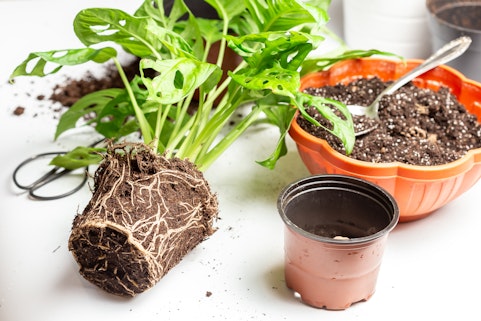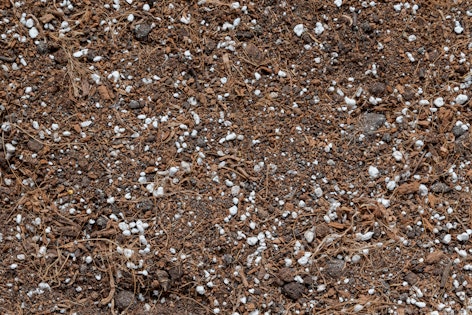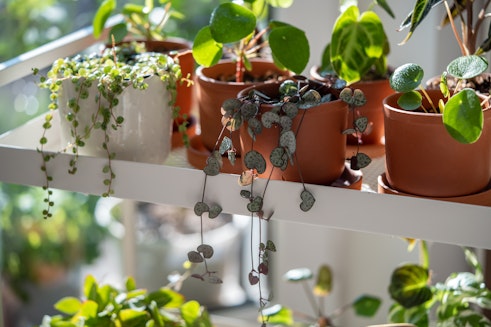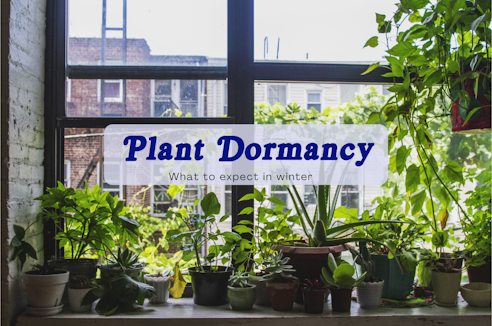
- Home
- Venus Flytrap (Dionaea muscipula) - The Lowdown
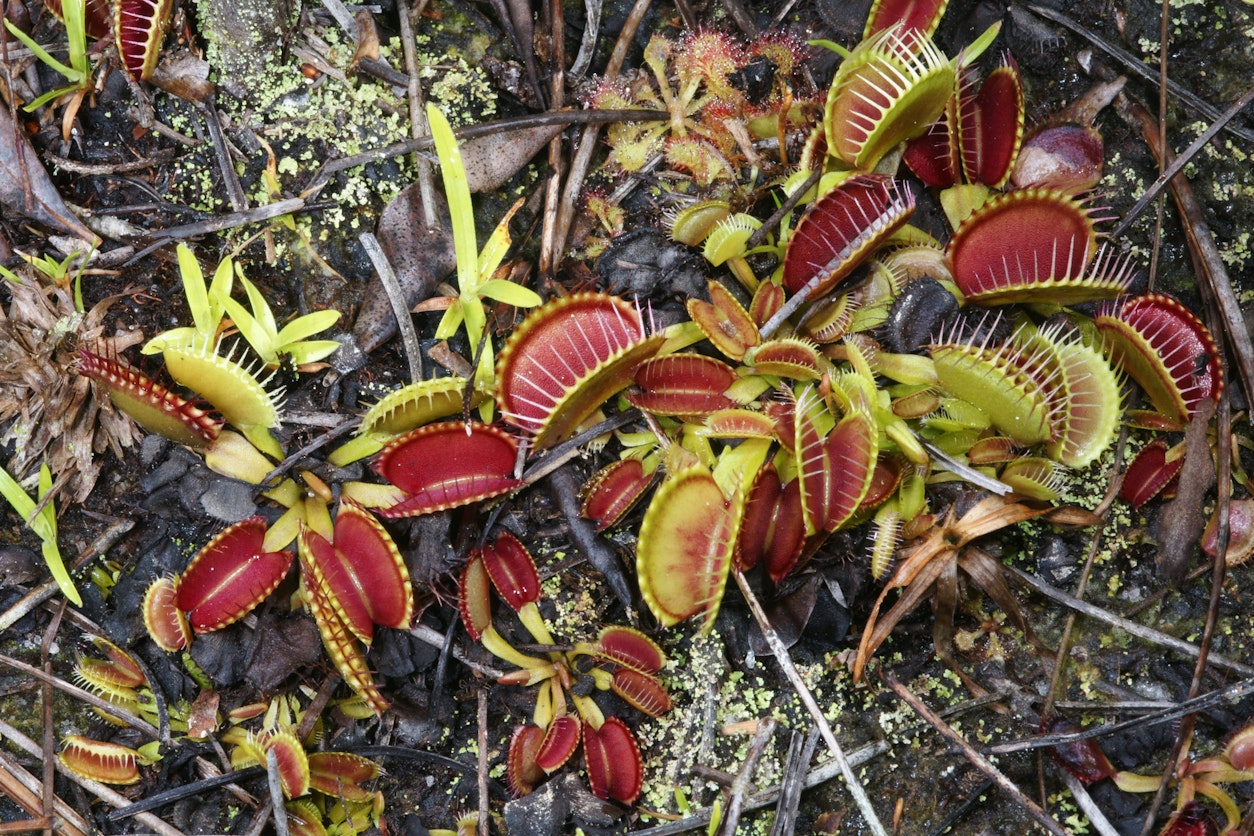
Check out these magical plants - their 'jaws' hang open, tempting unsuspecting prey to wander in. And snap! The crimson mouth clamps shut, trapping its next meal. The Venus Flytrap is one of the most recognisable and well known carnivorous plants, it’s a regular at the shop but outside of cultivation it is endemic; native to only a small spot in the Carolinas.
Its’ scientific name Dionaea muscipula comes from the ‘Daughter of Dione’, the Greek goddess Aphrodite and the specific epithet is Latin for ‘mousetrap’. While their common name suggests they’re diet is flies, in their natural habitat they consume mostly ground dwelling insects like ants, spiders and beetles.
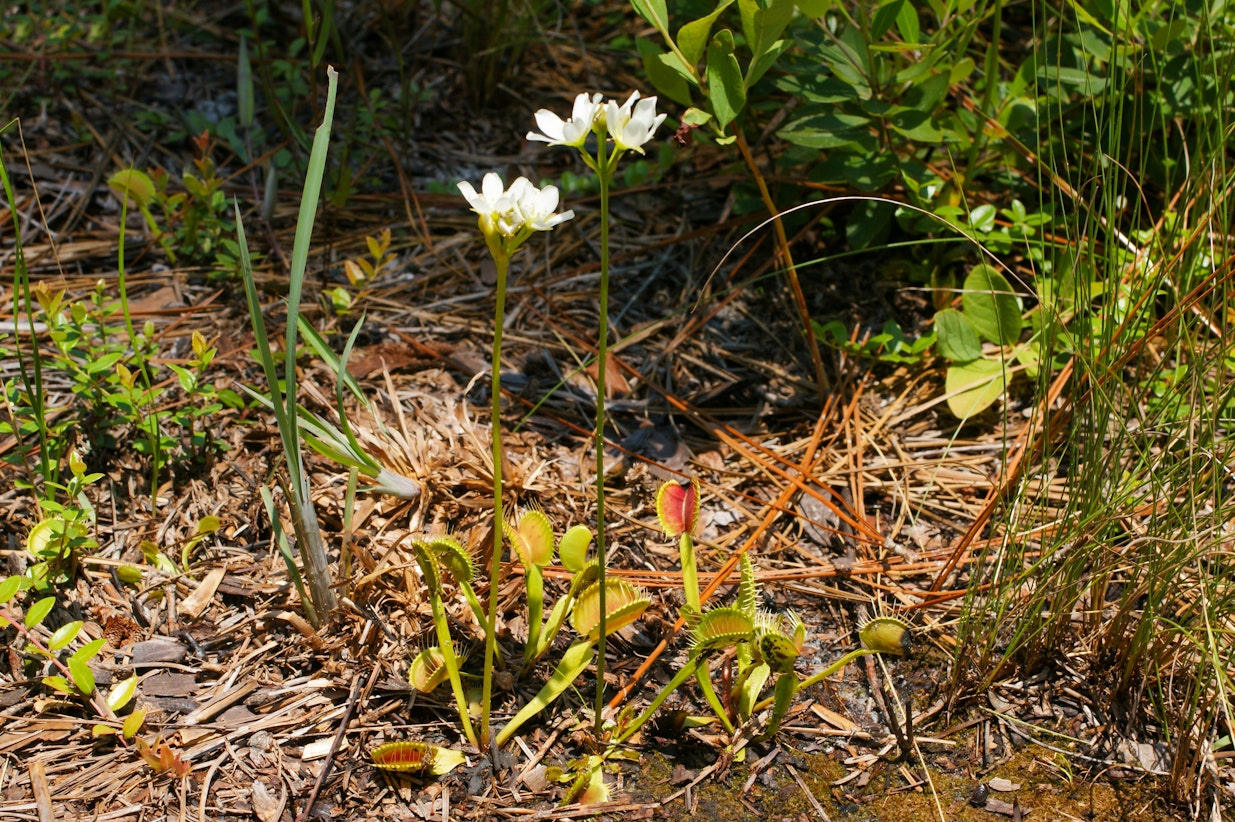
Why do they eat bugs?
Dionaea muscipula grow in bogs in the wetlands of North and South Carolina where the soil is particularly poor and low in nitrogen and phosphorus; natural selection has allowed these plants to evolve to get nutrients from the consumption of animals as a way of supplying themselves with the nutrients they are unable to obtain from their environment.
How Does the Venus Flytrap Work? How do they trap bugs?
The Venus Flytrap is composed of up to 7 leaves, the leaves are then divided into an upper leaf and a lower leaf. The upper leaf is considered the trap; it has two lobes which are held together by the midrib and the edges have cilia which link together when the trap closes.
Each lobe contains 3-5 sensitive trigger hairs which are arranged in a triangular formation, two of these hairs have to be stimulated within 20 seconds of each other for the trap to shut.
The mechanical stimulation of the trigger hairs generates a receptor potential (RP) followed by an action potential (AP) which leads to an electrochemical signal for trap closure. This trapping motion of this plant is one of the fastest movements in the plant kingdom.
At first the trap lobes close quite loosely, the cilia are interlocked enough to prevent larger prey escaping but smaller prey would be able to get free. After prolonged stimulation the trap will fully close, forming a watertight seal. The digestive glands lining the insides of the traps are activated and begin to secrete mucilage, pitcher fluids, acids, and proteins, including digestive enzymes.
There is a whole chapter in ‘In Defense of Plants’ about plants eating animals, it’s such a good read.
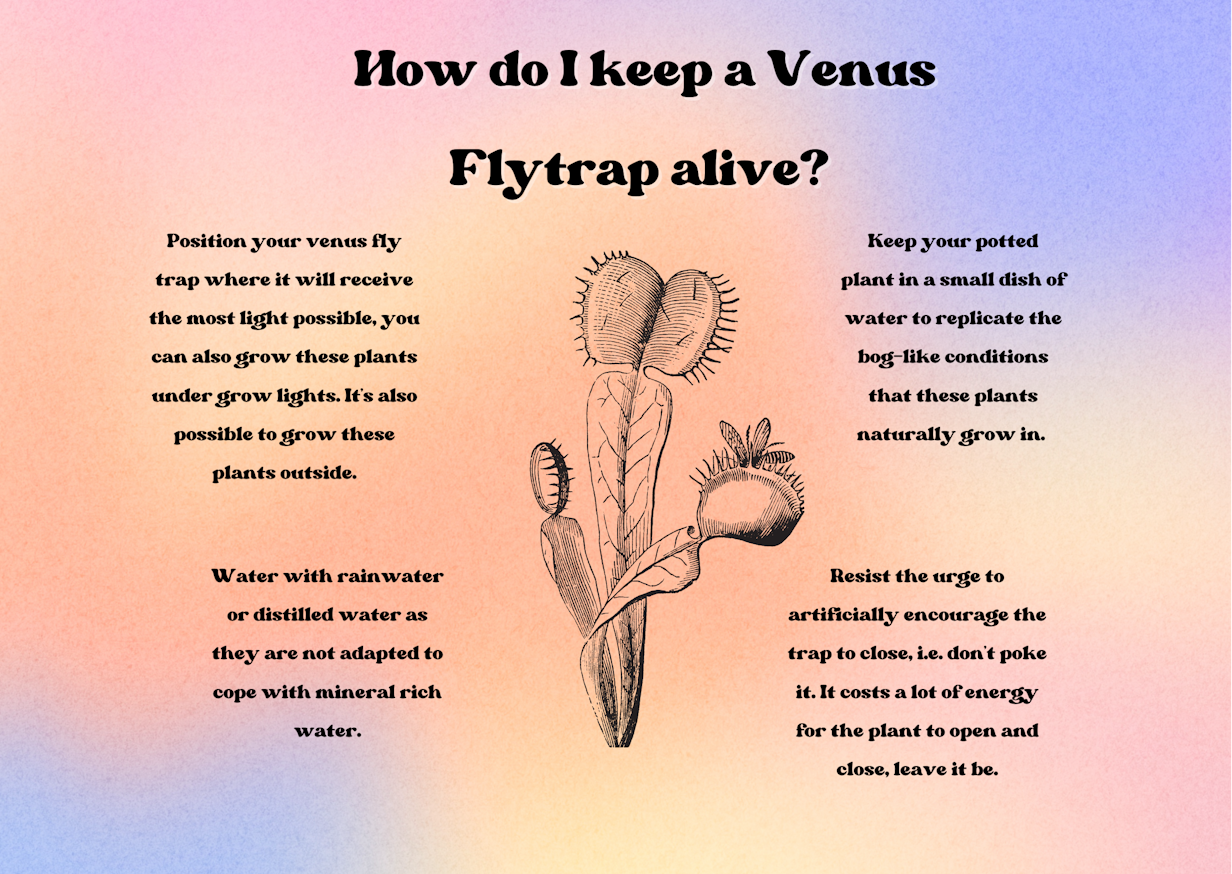
Do I have to feed a Venus Flytrap?
This is a tricky one with a lot of conflicting information online; the International Carnivorous Plant Society encourages growers to feed their plants every two weeks, whereas a lot of the scientific papers I’ve referenced suggest that the plants aren’t naturally capturing insects with particularly high rates so it’s not necessary to feed them. A study in 2017 by Stephen E Williams and Siegfried R. H. Hartmeyer measured the capture rates of Dionaea to find that they are low, about one capture/leaf/month in its native habitat (7), this also suggests that alluring agents (VOCs) drawing prey either do not exist or are ineffective.
What potting mix should I use for a Venus Flytrap?
The typical carnivorous plant potting mix is peat and sand but as we know peat is unsustainable so opt for using sphagnum moss. You could also use a mix of fine milled bark, lime-free horticultural grit and perlite.
Should you cut off dead Venus Flytraps?
Individual leaves on the plant will only last a few months, they then turn yellow and eventually black; you can pluck or snip them to prevent mould forming.
Can I put my Venus Flytrap outside?
Yes, you can keep your plant outside when night temperatures are above 10˚C.
Do Venus Flytraps flower?
Yes; in their native environment they are primarily pollinated by bees and beetles. There are conflicting ideas about whether you should cut the emerging flower stalk off or not. Some sources say to snip it to prevent the plant wasting energy on a flower when we want them to grow traps. Ultimately, it’s up to you whether you make the cut or not, if you do, do so as soon as they appear, snipping them at the base.

References
- Yang, Ruoting & Lenaghan, Scott & Zhang, Mingjun & Xia, Lijin. (2010). A mathematical model on the closing and opening mechanism for Venus flytrap. Plant signaling & behavior. 5. 968-78. 10.4161/psb.5.8.12136.
- Waltraud X. Schulze, Kristian W. Sanggaard, Ines Kreuzer, Anders D. Knudsen, Felix Bemm, Ida B. Thøgersen, Andrea Bräutigam, Line R. Thomsen, Simon Schliesky, Thomas F. Dyrlund, Maria Escalante-Perez, Dirk Becker, Jörg Schultz, Henrik Karring, Andreas Weber, Peter Højrup, Rainer Hedrich, Jan J. Enghild, The Protein Composition of the Digestive Fluid from the Venus Flytrap Sheds Light on Prey Digestion Mechanisms*, Molecular & Cellular Proteomics, Volume 11, Issue 11, 2012, Pages 1306-1319.
- Hartmeyer, Siegfried & Hartmeyer, Irmgard & Williams, Stephen. (2019). Dionaea traps selectively allow small animals to escape. Carnivorous Plant Newsletter. 48. 153-160. 10.55360/cpn484.sh674.
- Freund, Matthias & Graus, Dorothea & Fleischmann, Andreas & Gilbert, Kadeem & Lin, Qianshi & Renner, Tanya & Stigloher, Christian & Albert, Victor & Hedrich, Rainer & Fukushima, Kenji. (2022). The digestive systems of carnivorous plants. Plant Physiology. 190. 10.1093/plphys/kiac232.
- Kreuzwieser, Jürgen & Scheerer, Ursel & Kruse, Jörg & Burzlaff, Tim & Honsel, Anne & Alfarraj, Saleh & Georgiev, Plamen & Schnitzler, Jörg-Peter & Ghirardo, Andrea & Kreuzer, Ines & Hedrich, Rainer & Rennenberg, Heinz. (2014). The Venus Flytrap attracts insects by the release of volatile organic compounds. Journal of experimental botany. 65. 10.1093/jxb/ert455.
- M. Escalante-Perez, E. Krol, A. Stange, D. Geiger, K.A. Al-Rasheid, B. Hause, E. Neher, R. Hedrich. A special pair of phytohormones controls excitability, slow closure, and external stomach formation in the Venus flytrap. Proc. Natl. Acad. Sci. U.S.A., 108 (2011), pp. 15492-15497.
- Williams, Stephen & Hartmeyer, Siegfried. (2017). Prey capture by Dionaea muscipula- A review of scientific literature with supplementary original research. Carnivorous Plant Newsletter. 46. 44-61. 10.55360/cpn462.sw296.
- https://www.thecps.org.uk/
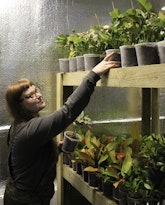
Lisa Price
Lisa Price is the visionary founder behind Root Houseplants, a thriving venture that has blossomed into one of Liverpool's most beloved botanical havens. With an intuitive passion for greenery and an entrepreneurial spirit, Lisa embarked on her journey to bring the beauty of nature into urban spaces. Driven by her personal quest for unique and affordable houseplants, Lisa recognised a gap in the market and decided to take matters into her own hands. In 2017, she took the leap, establishing Root Houseplants to provide enthusiasts with a diverse array of botanical treasures. Through dedication and determination, Lisa's business flourished from its humble beginnings on eBay to a thriving online platform and eventually, a brick-and-mortar store in Liverpool previously in West Kirby. Root Houseplants quickly gained recognition for its exceptional offerings, from prestigious publications such as The Times, Living Etc, and Independent Liverpool. Lisa's expertise extends beyond being a business owner; she is an advocate for plant education and community engagement. Root Houseplants isn't just a shop—it's a hub where enthusiasts gather to exchange knowledge, share stories, and foster a deeper connection with nature. Lisa's love for plants goes beyond the business realm; it's a personal passion that permeates every aspect of her life. When she's not tending to her extensive collection of Hoya, Aroids and Arids, Lisa can be found at home with her beloved sausage dog, Bubs, or indulging in her guilty pleasure of binge-watching Grey’s Anatomy and cooking shows in her pyjamas. Root Houseplants continue to thrive, spreading joy and greenery throughout Liverpool and beyond. Her unwavering commitment to quality, sustainability, and customer satisfaction ensures that Root remains a cherished destination for plant enthusiasts seeking to cultivate their own urban oasis.
More by Lisa PriceRelated Articles
View all articles
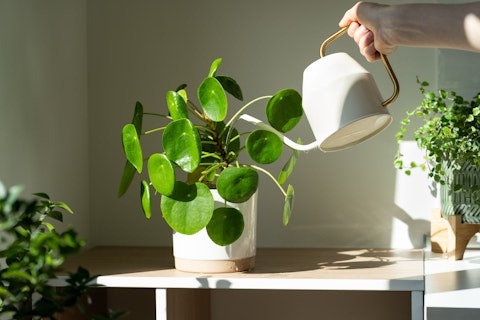
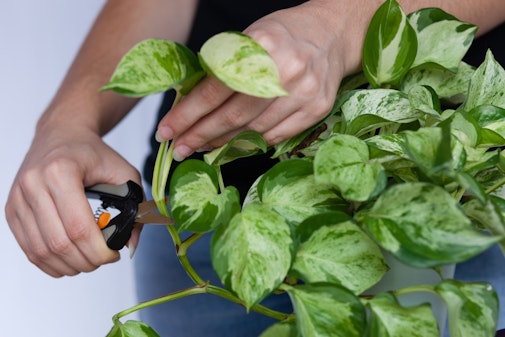
General Houseplant Care
Propagating Plants - Making new plants from the ones you have already
By Jonathan Davies
